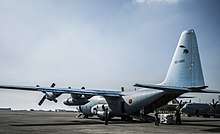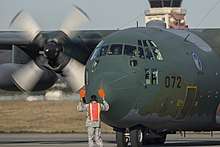401st Tactical Airlift Squadron (JASDF)
| 401st Tactical Airlift Squadron | |
|---|---|
| 第401飛行隊 | |
.jpg) C-130Hs of 401st Squadron | |
| Active | October 1, 1958 |
| Country | Japan |
| Allegiance | 1st Tactical Airlift Group |
| Branch | Japan Air Self-Defense Force |
| Garrison/HQ | Komaki Air Base |
| Aircraft flown | |
| Transport | Lockheed C-130H, Lockheed KC-130H |
The 401st Tactical Airlift Squadron (第401飛行隊 dai-yon-zero-ichi-hikoutai) is a squadron of the 1st Tactical Airlift Group of the Japan Air Self-Defense Force (JASDF) based at Komaki Air Base in Aichi Prefecture, Japan. It is equipped with Lockheed C-130H Hercules and Lockheed KC-130H Hercules aircraft.[1][2]
The C-130H has a greater range than its predecessor the Kawasaki C-1, and since the 1980s Japan's posture has gradually become more outward-looking and the Self-Defense Forces have become more involved in activities beyond Japan's shores. These have included humanitarian relief and evacuation missions, supporting US and Japanese military activities, and participation in multi-national military exercises.
History
Since the introduction of the Lockheed C-130H Hercules in the 1980s aircraft of the squadron have deployed overseas on many occasions.
Humanitarian missions
On several occasions in the 1990s Japan dispatched squadron C-130s to prepare for possible evacuations of Japanese nationals. In July 1997 one was sent to Thailand amid upheavals in Cambodia, and in 1998 six were sent to Singapore in case Japanese needed to be evacuated from Indonesia. As it happened neither evacuation was required.[3][4]
Japan did not participate in the Australian-led multinational intervention in East Timor, but in 1999 a squadron C-130s was sent to West Timor in case Japanese citizens needed to be evacuated.[5] From November 26 1999 to February 1 2000 three C-130s from the squadron including one backup flew a humanitarian airlift. In 47 rotations the aircraft transported 402 tons of supplies in Kupang, West Timor.[6]
In October 2001 six squadron C-130s transported humanitarian aid (tents, blankets and relief supplies) for Afghan refugees in Pakistan.[7][8]
Afghanistan and Iraq
Almost half of Japan's C-130s were used in support of Operation Enduring Freedom, the US-led campaign against Afghanistan. While not participating in Afghanistan directly they provided support by flying US equipment and personnel to Singapore, Guam and other places. This freed up US resources to focus on the war in Afghanistan.[9]
Squadron C-130s were active in Iraq from 2004 to 2008. The provided support to the Japan Ground Self-Defense Force contingent deployed there after the invasion.
Military exercises
Japan has taken place in the Cobra Gold military exercise in Thailand since 2005. In February 2017 a squadron C-130 was used in a drill for evacuating Japanese and US citizens[10][11] ending with a short flight.[12]
In March 2012, a year after the Royal Australian Air Force (RAAF) had assisted Japan following the 2011 Tōhoku earthquake and tsunami, one of the squadron's aircraft visited RAAF Base Richmond in Australia.[13]
The squadron has participated in the Cope North military exercise on a number of occasions, including in 2009,[14] 2013,[15] 2016[16] and 2017.[17]
In-flight refuelling
From 2010 two of the squadron's C-130Hs (95-1080 and 95-1083) have been equipped with aerial fuel-receiving and refueling functions, making them of KC-130H standard. This provides the JASDF with the ability to refuel the UH-60J search and rescue helicopters of its Air Rescue Wing.[18]
Other missions

In response to Typhoon Haiyan hitting the Philippines in November 2013 squadron C-130s were deployed, along with other SDF aircraft.[19][20][21][22][23]
After the disappearance of Malaysia Airlines Flight 370 in March 2014 two of the squadron's aircraft were sent to Subang Airport in Malaysia to assist in the search.[24]

One aircraft participated in December 2015 edition of the US Air Force's Operation Christmas Drop in the Pacific, along with one RAAF C-130J and three US C-130s.[25][26][27][28][29] The JASDF and RAAF also participated in the 2016[30] and 2017 operations.[31][32]
In January 2016 after North Korea claimed to have exploded a hydrogen bomb, a squadron C-130, along with three Kawasaki T-4 aircraft, were used to test for radioactive particles. The flights were done for around 14 days.[33][34][35][36] The flights did not detect any radioactive particles.[37]
In a mission lasting from July 11 to July 26th 2016,[38] three of the squadron's C-130s were sent to Japan Self-Defense Force Base Djibouti to evacuate Japanese citizens from Juba in South Sudan after fighting broke out there.[39][40][41] They were expected to pick up around 70 Japanese citizens.[42] It was also announced that some of the people to be evacuated were non-Japanese working with the Japan International Cooperation Agency (JICA).[43] By July 14th the aircraft had evacuated 47 Japanese nationals to Nairobi in Kenya, and took four Japanese embassy employees to Japan Self-Defense Force Base Djibouti. Around 20–30 Japanese remained in Juba.[44][45]
Tail marking
The tail-marking of the 401st Squadron was a red "Shachihoko", or killer whale, with Nagoya Castle on a blue background and a figure "1", which represented the "1"st Tactical Airlift Group commanding the 401st Squadron. This tail-marking is no longer used on their C/KC-130H aircraft.[46][47]
Aircraft operated
- Curtiss C-46 (1968–1978)
- NAMC YS-11P (1969–1989)
- Kawasaki C-1 (1973–1989)
- Lockheed C-130H Hercules (1984–)
- Lockheed KC-130H Hercules (2010–)
References
- ↑ Thompson, Paul JASDF – Order of Battle July 1, 2017 J-HangarSpace Retrieved September 13, 2017
- ↑ 1st Tactical Air Group Retrieved September 13, 2017 (in Japanese)
- ↑ "Japan and North America: The postwar, Volume 2". 2004. Retrieved November 20, 2017.
- ↑ "Foreign Naval Presence Builds Around Indonesia". worldview.stratfor.com. May 20, 1998. Retrieved November 20, 2017.
- ↑ Green, Michael J (2001). "Japan's Reluctant Realism". books.google.co.jp. Retrieved November 20, 2017.
- ↑ "Japan ends humanitarian airlift in West Timor". unhcr.org. February 1, 2000. Retrieved November 20, 2017.
- ↑ "International Peace Cooperation for the Relief of Afghan Refugees – Photo Digest –". mofa.go.jp. 2001. Retrieved November 16, 2017.
- ↑ Penn, Michael (2014). "Japan and the War on Terror". books.google.co.jp. Retrieved November 20, 2017.
- ↑ Williams, Brad (2006). "Japan, Australia and Asia-Pacific Security". books.google.co.jp. Retrieved November 21, 2017.
- ↑ "SDF holds first evacuation drill by land for Japanese nationals abroad". Japan Times. February 16, 2017. Retrieved November 19, 2017.
- ↑ "SDF holds first overseas rescue drills during Cobra Gold in Thailand". Japan Times. February 19, 2017. Retrieved November 19, 2017.
- ↑ Sissel, Matthew (February 21, 2017). "Nations practice non-combatant evacuations at Cobra Gold 17". marforpac.marines.mil. Retrieved November 19, 2017.
- ↑ "Japanese C-130 visits Richmond". australianaviation.com.au. Australian Aviation. March 20, 2012. Retrieved November 18, 2017.
- ↑ "Japan forces arrive in Guam for joint exercise". af.mil. January 28, 2009. Retrieved November 17, 2017.
- ↑ "Exercise Cope North Guam 2013 begins". airforce-rechnology.com. February 5, 2013. Retrieved November 17, 2017.
- ↑ "Cope North 16 Pacific partners sharpen air combat skills". pacaf.af.mil. February 25, 2016. Retrieved November 17, 2017.
- ↑ Skovo-Lane, Jacob (March 6, 2017). "Cope North 17 Concludes with Friendships Renewed, Skills Sharpened". pacom.mil. Retrieved November 17, 2017.
- ↑ "Boeing Team Delivers C-130H Aerial Refueling Tanker to Japan". Boeing Company. 20 April 2010. Retrieved 27 September 2017.
- ↑ "Typhoon Haiyan: Aid in numbers". BBC. November 14, 2013. Retrieved November 20, 2017.
- ↑ Yoshida, Reiji Massive SDF dispatch set for Philippine relief mission November 14, 2013 Japan Times Retrieved September 18, 2017
- ↑ Abbugao, Martin (November 22, 2013). "Japanese troops welcomed back in typhoon-hit Philippines". www.rappler.com. Retrieved November 20, 2017.
- ↑ Robson, Seth (November 19, 2013). "WWII foes US, Japan back in Philippines to help storm victims". Stars and Stripes. Retrieved November 20, 2017.
- ↑ Nakamura, Akira (March 27, 2014). "Looking back on the Dispatch of the Japan Disaster Relief Team to the Philippine Typhoon Haiyan Disaster Area". jica.go.jp. Retrieved November 20, 2017.
- ↑ "Japan's assistance in search of Malaysia Airlines MH370 (13 March) Two C130 arrive at Subang Airport". my-emp-japan.go.jp. March 13, 2014. Retrieved November 18, 2017.
- ↑ "Australia, Japan join U.S. Air Force in Pacific island Christmas food, toy drop that started in 1952". Japan Times. December 14, 2015. Retrieved November 18, 2017.
- ↑ Mekpongsatorn, Melissa K. (December 17, 2015). "Operation Christmas Drop showcases HA/DR Training". yokota.af.mil. Retrieved November 18, 2017.
- ↑ "Operation Christmas Drop showcases HA/DR Training". airliftmagazine.com. December 2015. Retrieved November 18, 2017.
- ↑ "The 2015 Operation Christmas Drop" (PDF). micronesia.emb-japan.go.jp. December 2015. Retrieved November 18, 2017.
- ↑ "Japan Air Self-Defense Force of Operation Christmas Drop". youtube.com. December 18, 2015. Retrieved November 18, 2017.
- ↑ Presentado, Cierra (December 12, 2016). "Operation Christmas Drop: Behind the Scenes". dia.mil. Retrieved November 19, 2017.
- ↑ Mediola, Tanya (December 12, 2017). "Operation Christmas Drop 2017 in Full Flight". navy.mil.
- ↑ "Operation Christmas Drop 2017 concludes". news,defence.gov. December 17, 2017. Retrieved June 7, 2018.
- ↑ Cenciotti, David (September 6, 2017). "These Aircraft Sampled Air For Radioactive Particles To Determine If North Korea Actually Detonated A Hydrogen Bomb". theaviatonist.com. Retrieved November 19, 2017.
- ↑ Lake, Jon (September 22, 2017). "Japan prepares for North Korean Bomb". asianmilitaryreview.com. Retrieved November 19, 2017.
- ↑ "JASDF deployed C-130, T-4s to take air samples to test for radioactive particles". alert5.com. January 2016. Retrieved November 19, 2017.
- ↑ "空自、引き続きT4練習機を派遣 C130輸送機も 放射性物質収集". Sankei Shimbun. November 19, 2017. (in Japanese)
- ↑ "JASDF aircraft failed to detect radioactive materials in air samples". alert5.com. January 2016. Retrieved November 19, 2017.
- ↑ イカロス出版 Jwing No.218 2016年10月号 8–9頁 「空自C-130H、法人救出ミッション」(in Japanese)
- ↑ "Japan sends military planes for evacuation of citizens in South Sudan". Reuters. July 11, 2016. Retrieved November 16, 2017.
- ↑ "Violence spurs Japan to evacuate workers from South Sudan". apnews.com. July 12, 2016. Retrieved November 16, 2017.
- ↑ Yoshida, Reiji SDF is ordered to evacuate Japanese nationals from South Sudan July 11, 2016 Japan Times Retrieved November 23, 2016
- ↑ "Violence spurs Japan to evacuate workers from South Sudan". Sun.Star. July 12, 2016. Retrieved November 16, 2017.
- ↑ "ASDF rescue flight for Japanese in South Sudan will also evacuate foreigners". Mainichi Shimbun. July 12, 2016.
- ↑ "Japan Embassy staff evacuated from South Sudan". Japan Times. July 14, 2016. Retrieved November 20, 2017.
- ↑ "Japan to expand SDF base in tiny but strategically important Djibouti". Japan Times. November 19, 2017. Retrieved November 20, 2017.
- ↑ "JASDF Squadron Histories | J-HangarSpace: Information on Japanese Aviation". www.j-hangarspace.jp. Retrieved 2018-02-20.
- ↑ "JASDF – Order of Battle | J-HangarSpace: Information on Japanese Aviation". www.j-hangarspace.jp. Retrieved 2018-02-20.
External links
| Wikimedia Commons has media related to 401st Tactical Airlift Squadron (JASDF). |